- Home
- slideshows
- miscellaneous
- The best fishing rods and reels
The best fishing rods and reels
The best fishing rod and reel overall

The best fly rod and reel for trout and most other freshwater species
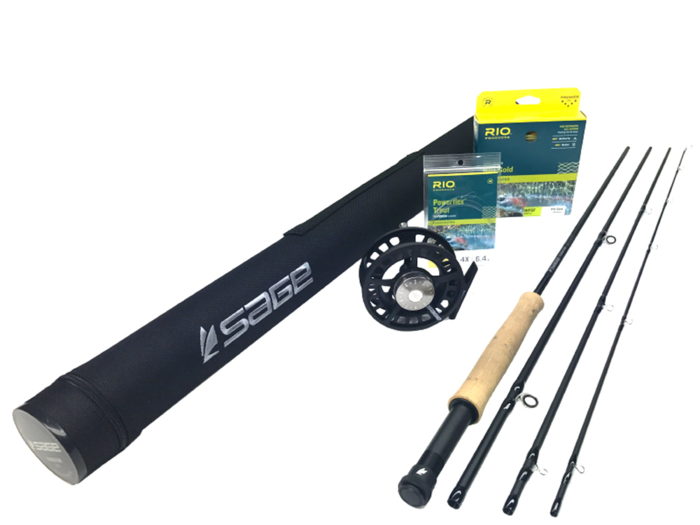
I've had multiple Orvis Clearwater outfits over the years, and the new Clearwater IV has been my favorite for an affordable, all-around trout rod. Yes, you can spend 10 times as much on a fly rod, but it could take you just as long to be able to point out any significant differences apart from actual physical weight. I've personally broken three of these rods through my own fault, and Orvis has repaired or replaced them each and every time (sometimes for a nominal $30 fee).
Fly rods and reels are defined by the weight of the line they cast, which effectively correlates to the size of fish they're designed to target. The Clearwater IV 9-foot 5-weight is about as versatile as a trout fishing fly rod gets, and the mid-flex rating makes it perfect for surface (or "dry") and subsurface (or "wet") fly fishing, both of which appreciate softer and stiffer flexibility, respectively. The cork handle holds up over the years, and that is often where other inexpensive fishing rods fall short. But even if your cork handle does start to fall apart, Orvis has you covered there, too.
The reel is nothing special, but fancy fly reels are anything but necessary for most trout fishing applications, and so long as you keep it out of the saltwater, the Clearwater IV reel should last about as long as any. If, however, you must take it into the brine, be especially sure to disassemble and thoroughly rinse it with fresh water afterward, leaving it out with the reel and spool apart to fully dry before reassembling.
Moreover, the drag on the reel isn't anything to write home about, but it will handle large trout (up to about 10 pounds) in fast water without much, if any trouble, which is about all I've ever asked of a 5-weight reel. Fly line, backing, and even a leader are all included. They are all usually separate expenses that easily add up to over $50, so this package is even more of a steal.
Frankly, for a trout rod, there's little if any need to look further, but if you're after something more lightweight and technical, the Sage X rod and reel combo is a worthy jump, and the partially sealed reel that it comes with will likely outlast Orvis' Clearwater IV.
Pros: Versatility, includes line, backing, and leader, 25-year warranty
Cons: The reel doesn't come well-greased, so make sure to take it apart and apply reel lubricant before initial use
Buy the Orvis Clearwater IV Outfit on Amazon for $311.00 Buy the Sage X rod and reel combo on Amazon for $1,284.00The best fly rod and reel for most saltwater fish
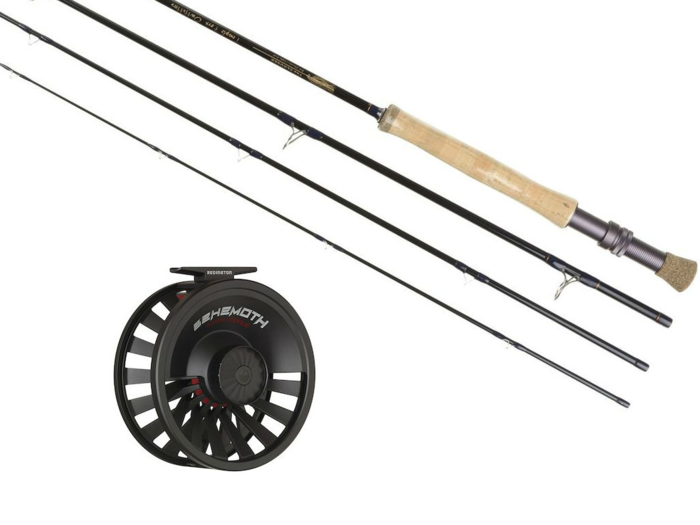
A 9-foot 9-weight is your standard, middle-of-the-road fly rod and reel for general saltwater usage. A 7- or 8-weight is more popular for bonefish, while a 10- to 12-weight is more appropriate if you're after tarpon (10 weight for smaller fish, 12 for the 100-pound+ range), and anything above a 12-weight is generally saved for offshore pelagic species like mahi mahi, tuna, and billfish.
Temple Forks Outfitters is a cooperative comprising a dream team of fly fishing's greats, from founder Gary Loomis (of G. Loomis) to Lefty Kreh, Bob Clouser, and Flip Pallot — among others — and there are few people I'd trust more to advise me on a quality fly rod at an accessible price. One such person, venerated Turks and Caicos flats fishing guide Captain Will Valley of Bonefish Unlimited, swears by them.
The one thing you might notice if you happen to find yourself switching between an outfit like TFO's Clouser fly rod with Redington's Behemoth reel and a fancier, exponentially more expensive setup like Sage's Salt HD rod paired with a Tibor Everglades reel is weight, which does have a bearing on your ability to cast all day.
Throwing a fly rod does tire your arm out more quickly than most other forms of recreational fishing, and a few ounces will make a difference throughout the day, but it isn't worth the price tag for most anglers, novice and seasoned alike.
Redington's Behemoth reel has been a hot topic for a couple of years now, and although I haven't personally gotten my hands on it, the swathe of positive reviews and personal recommendations I've encountered — particularly Hatch Magazine's, especially after reading that it survived a tangle with a bottlenose dolphin (don't worry, it wasn't harmed) — have left me in good faith that I won't be disappointed when I get mine.
Pros: Rod flexibility increases with amount of line being thrown, increasing casting distance, especially for otherwise hard-to-cast wet (sinking) lines and weighted flies; reel has smooth drag
Cons: Rod does not come with a rod tube ($29.95), which you'll need to buy if you're going to travel; Reel is not anodized, but few if any reels are at this price
Buy the Temple Forks Outfitters Clouser 9-Weight on Amazon for $199-$229.95 Buy the Redington Behemoth Fly Reel on Amazon for $109.95-$139.99 Buy the Sage Salt HD rod on L.L. Bean for $950.00 Buy the Tibor Everglades reel on Bass Pro Shop for $695.00The best rod and reel for live bait fishing
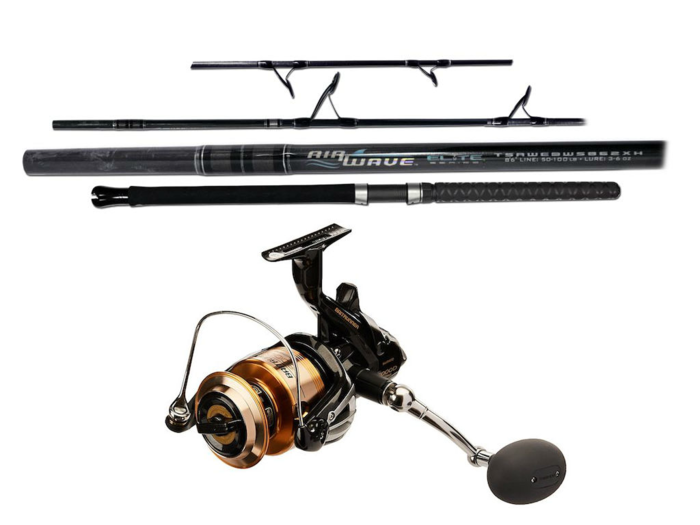
The Tsunami Airwave Elite was a new rod for me this year, but avid fishing friends have been swearing by them for two years, and I was quick to learn why. Despite being lightweight, it's sturdy, and the silicon carbide (SiC) guides held in place by a robust titanium frame help keep them from getting bent out of place — or broken — in transit.
I'm also a huge fan of the Airwave Elite's diamond-textured shrink vinyl grips, which are a nice surprise on a relatively economical rod. While most fishing rods come with either a soft EVA foam or cork grip, both of these materials get chewed up pretty easily over time.
But after two years of general wear and tear up and down the New England coast, the vinyl grips on the Airwave Elites I tested out this past weekend bore not even a scratch — a far cry from most of the grips on my rods, which all at least have a good gash or two. I'm still curious as to what might damage, let alone break one of these rods.
There are plenty of solid live bait reels that include a lighter, more finely-tuned secondary drag to allow a fish to strike without detecting the restraint, but my favorite, longest-surviving reel remains the Shimano Baitrunner D series. It's sturdy, of course, but it's also streamlined and lightweight enough to be used for other applications other than sit-and-wait bait fishing, which is why it gets my praise.
I'm just as comfortable casting lures or even doing a little lightweight trolling with this reel —especially when paired with the Airwave Elite. It also has no trouble handling braided line, which, being finer than traditional monofilament or fluorocarbon fishing line, has a penchant for getting caught up and frayed or cut clean off in any crevices or snags that present themselves. This reel is definitively smooth, and the oversized grip makes it much more comfortable than most, especially when fighting larger fish or retrieving lures all day.
If it's a surf rod you're after, Tsunami's Airwave Elite 11'4" spinning rod will serve most surfcasting purposes, and the Shimano Baitrunner D Series reel will still work well, but if you do want to forgo the secondary gear feature, the Okuma Azores series has been a favorite of mine, mainly for its large spool and handle, which you come to appreciate when you have a football field worth of line to reel in.
Pros: Every component of the Airwave Elite is of high quality and built to last; the Baitrunner D Series is sleek, versatile, and replacement parts (should you need them) are readily available through Shimano
Cons: Not all Airwave Elite models come with a gimbal for more secure storage in rod holders; Baitrunner D has a graphite frame as opposed to full metal, which is fine, as long as it doesn't take a catastrophic fall, at which point it is much more likely to break
Buy the Tsunami Airwave Elite on J&H Tackle for $149.95 Buy the Shimano Baitrunner D on Amazon for $169.99-$214.36 Buy the Tsunami Airwave Elite surfcasting rod on Amazon for $229.99 Buy the Okuma Azores on Amazon for $90.26-$104.41The best rod and reel for trolling and deep sea bottom fishing
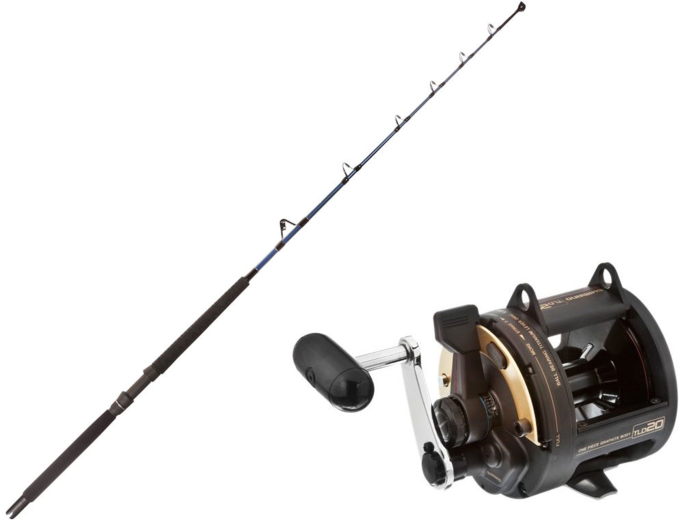
Whether you're casually dragging a single lure behind your boat or actively fishing a spread of six or eight lines, it's important to have a trolling rod and reel capable of handling large fish, which can critically damage under-equipped gear and leave you with an even deeper hole in your pocket once you've made the necessary repair(s) or replacement(s).
While passing through a particularly remote part of Fiji, our trolling gear gave out on us and we were reduced to hand lines — which work perfectly well, but aren't for everyone — and otherwise inferior tackle until we reached New Zealand, where the captain ended up having to invest in all new gear. We lost more fish than either of us care to recount along the way.
Choosing the right trolling gear can be difficult: too lightweight, and you might destroy your tackle, or leave a fish with a lure and spool of line attached to it; too heavy-duty, and there won't be much sport involved in retrieving (most) smaller fish. Consider where you'll be trolling most of the time, and whether or not the chances of hooking a trophy are worth the extra weight.
If you're trolling inshore and your catch is most likely to stay within the 50-pound range (think inshore species like salmon, and maybe small mahi mahi and tuna offshore), the Shimano TLD rod and reel combo will work perfectly.
If you do find yourself trolling offshore more, something a little sturdier will save you time, money in the long run, and quite possibly even a little heartache, which is why I would go straight for one of Penn's International series reels and pair it with Penn's Ally Standup Rod.
Tip: If you'll be using this setup on a sailboat, consider a short — either 5-foot-6-inch or 6-foot — model for better maneuverability around the boat's rigging.
Penn's International reels have been a favored reel since my grandfather was catching tuna, and I still have and use a few of his old ones. The modern version of the International V comes with a one-piece machined aluminum frame, which helps prevent salt and grit from entering the inner workings of the reel. The more seams there are in a reel, the more points of entry there are for water and grit to find their way in, and in the case of saltwater, that can mean game over without prompt attention.
Penn's Ally standup series suits most purposes, but choose the style that's best accommodated by you and your boat, and make sure you at least purchase a model with a gimbal, which not only locks the rod into its holder but allows it to pivot in a fighting belt or chair — as opposed to, say, your hip or thigh, which can be painful. You can step your rod up or down as needed, but it's best to purchase a rod with roller guides if you're using line over 50-pound test, which will wear groves in regular O-ring guides over time.
Pros: Most models of both setups will work for bait and bottom fishing, too
Cons: Heavy, cumbersome to stow
Buy the Shimano TLD trolling rod and reel combo on Bass Pro Shops for $269.98-$309.98 Buy a Penn International series reel on Amazon, starting at $502.71 Buy the Penn Ally trolling rod on Bass Pro Shops for $66.97 to $249.95The best rod and reel for deep-sea bottom fishing
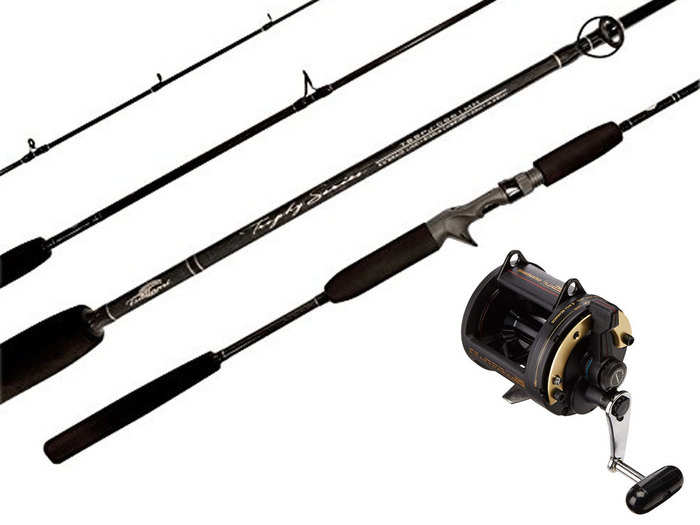
The same reel you'd use for light trolling is exactly what you'll want if you're bottom fishing in relatively deep water (say over 40 feet), but you can (and probably want to) go a little lighter-weight, at least with the rod. A spinning rod does the trick to a point, but you'll want an open-faced reel with a more fine-tuned drag, and a stiffer rod for better leverage, especially if you're pulling fish up out of structure where they might get stuck.
Tsunami makes some of the most durable rods on the market, and while they're often about twice the price of many Ugly Stiks, they're much higher-performance, and, in my experience, probably bound to outlive any Ugly Stik, though this is just my gauge based on a couple years' use)\.
This is, as many Amazon reviews attest, your go-to rod for bottom fishing, where a stiffer rod and a lever drag come in handy. If you're not looking to get crazy with a fishing rod quiver but want to do a bit of everything, you might just stick with our spinning rod and reel pick. But, if you're going to be doing a lot of bottom fishing, especially from a boat, this is the tool for the job. Snapper, grouper, striped bass, cod, sea bass, fluke, and halibut all call for this sort of gear when bottom fishing.
As for a reel, the Shimano TLD is your reel. It's not only easier to fight fish at a vertical angle with an open-faced, or conventional reel; it's a lot easier to make adjustments to your drag and retrieve and drop your bait, too. These reels are around for the long haul, and you won't have any trouble tracking down replacement parts going forward. They're also extremely well priced in respect to their quality, and I haven't found much of anything reliable and widely available (or serviced) within this price range.
Now that my fishing buddies and I have a bit more disposable income, this is the setup with which we've been replacing our old Ugly Stik and lower-end and aging reels. It hasn't made better anglers of us by any means, and I'd be a bold-faced liar if I were to promise anything of the sort to you. It will, however, likely outlast more of your mishaps.
Pros: Sturdy, easy to find replacement parts for reel when the time comes
Cons: Not inexpensive, but still a great price for the quality
Buy the Tsunami MH Slow Pitch Jigging/Casting Rod on Amazon for $109.95 Buy the Shimano TLD with lever drag on Amazon for $129.99-$194.53, depending on sizePopular Right Now
Popular Keywords
Advertisement